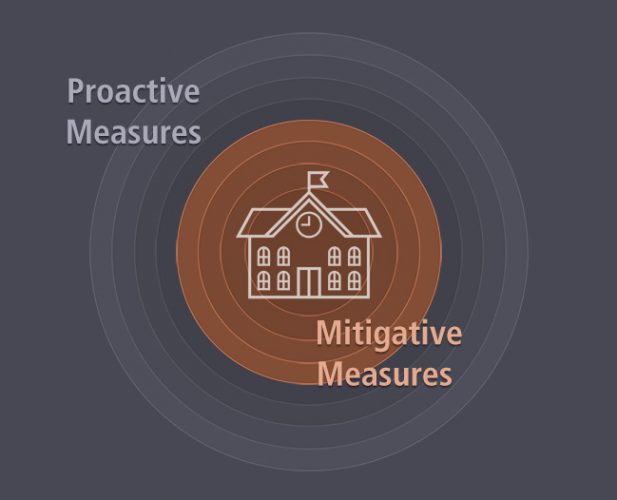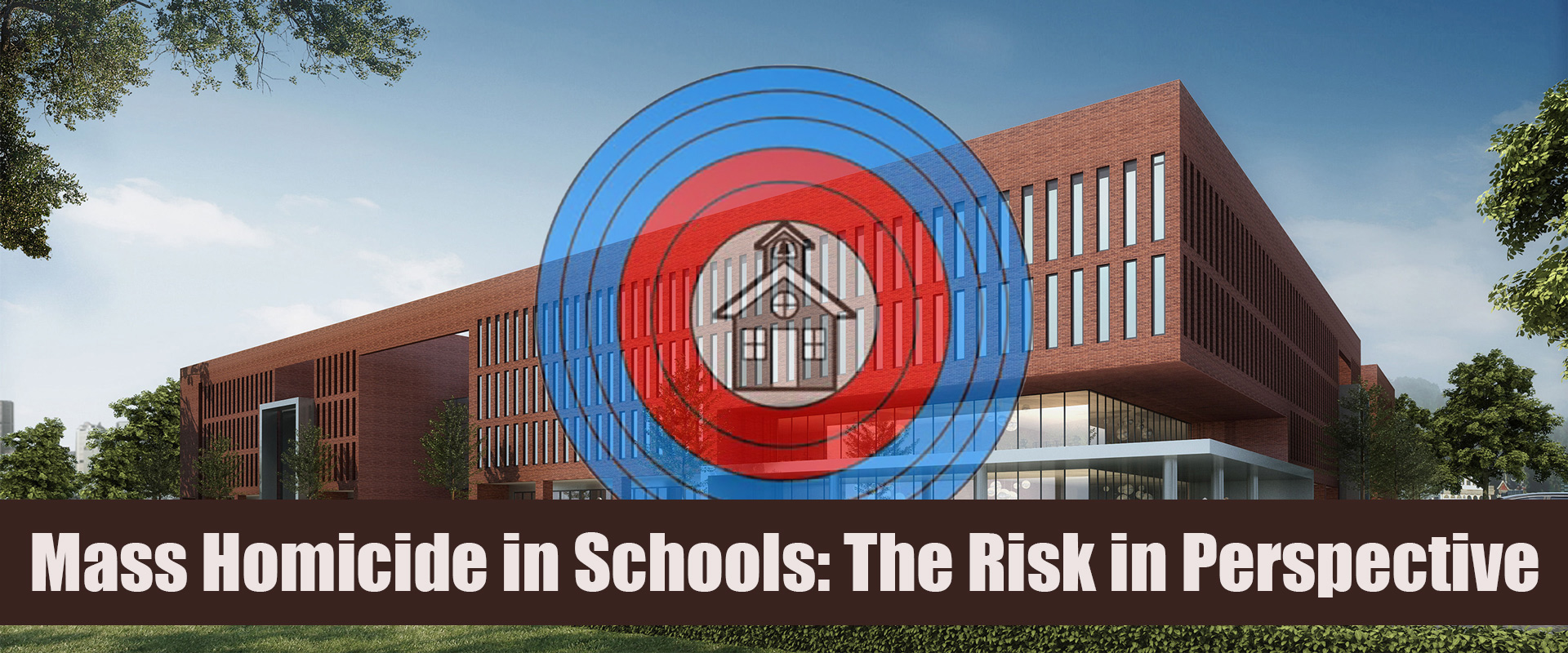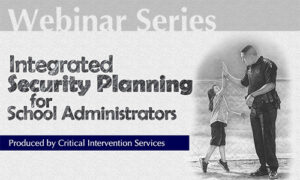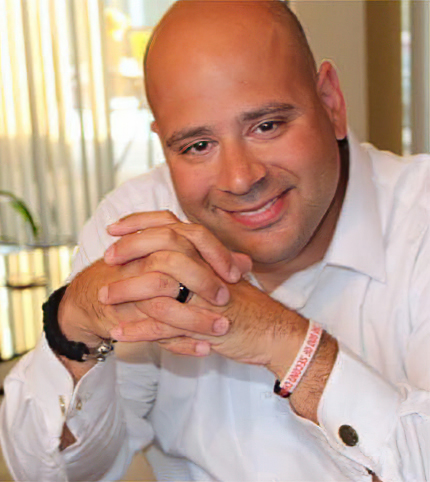
Barrier Delay Measures and The Double Edged Sword
While assisting a reporter after the Uvalde shooting, a question was posed that maybe warrants some discussion. During the interview, I described some examples of
The Critical Difference™

Over the past three decades, horrific acts of mass violence have occurred in schools ranging in size and complexity from state universities and large public schools to a one-room Amish schoolhouse. As witnessed time and again, no school is immune to the risk of targeted violence.
In response to the public need for an effective strategy for reducing the risk of school violence, Critical Intervention Services launched the Guardian SafeSchool Program® as a holistic, integrated program employing a multi-layered strategy to reduce risks of mass homicide. The strategy and methods underlying the program are based on hundreds of hours of development and supported by over 25 years of experience in controlling risks of targeted violence in diverse social environments.
Since the program’s launch in 2013, the uniquely integrated and comprehensive nature of the program has earned national-level recognition from the criminal justice and school safety communities including accolades in peer review by John Jay College of Criminal Justice.
Over the past nine years, our consultants have assisted a diverse range of schools, district organizations, and post-secondary institutions in improving their level of security and emergency readiness in alignment with our Guardian SafeSchool Program® standards.
At the foundation of the Guardian SafeSchool Program® is a multi-layered strategy aimed at preventing violence while employing performance-based physical security measures and emergency preparations to reduce the impact of events.
The following diagram describes how these measures contribute to risk reduction graphically depicted as rings of protection.

In the Guardian SafeSchool Program® strategy, proactive risk management starts with reducing potential threat. This is first accomplished by reducing potential conditions that contribute to violent intent and acceleration on the pathway to targeted violence. Examples of measures aimed at reducing threat include establishing policies and practices that reinforce positive school climate and culture, social-emotional learning programs, engendering trust and rapport between staff and students, mentoring students with problems, actively intervening in bullying situations, and restorative practices.
For schools pursuing compliance with the Guardian SafeSchool Program® Standards, Standards 2.1-2.3 are dedicated to issues related to school climate and culture.
In addition to measures designed to reduce violent intent, the Guardian SafeSchool Program® defines requirements for establishing a formal system for identifying and reporting potential threats and behavior of concern, investigating and assessing threats, and managing potential threatening situations. When engaged as consultants to develop a threat assessment program, we employ a threat assessment approach based on the Comprehensive School Threat Assessment Guidelines (CSTAG) as the base methodology with additional assessment considerations based on validation research by Dr. Jens Hoffmann using the Warning Behavior Typology as related to juveniles.
For schools pursuing compliance with the Guardian SafeSchool Program Standards, Standard 2.4 addresses threat assessment plans, reporting measures, threat assessment teams, and faculty training.
Positive school culture and threat assessment measures reduce the risk of a student progressing toward violence, but these measures have little benefit against outsider adult adversaries or students who progress undetected toward violence. The only way to effectively mitigate potential tragedy in these situations is having effective physical security measures. Effective physical security requires that a threat is detected early and delayed from committing mass homicide sufficiently for a response force to intervene.
Accomplishing this performance-based goal requires effective layers of barrier delay (e.g., intrusion-resistant windows, doors, etc.), ample availability of intrusion-resistant classrooms, careful access control design and hardware specification for simplicity and quick performance under high stress conditions, effective egress measures, and having an on-site armed response capability.
For schools pursuing compliance with the Guardian SafeSchool Program® Standards, Standard 3 is devoted to physical security measures including outdoor grounds, building facade and entrance design, secure visitor reception and control, access control systems, secure classroom design, and egress conditions.
The last layer of defense in the Guardian SafeSchool Program® is emergency preparation for managing crisis situations safely, effectively, and restoring school operations as quickly as possible. Examples of measures include having effective and well-organized school emergency response plans, reliable and rapid emergency communications systems, reunification preparations, and training faculty on critical emergency response procedures.
For schools pursuing compliance with the Guardian SafeSchool Program Standards, Standard 4 addresses emergency response teams, communications systems, medical preparations, emergency response plans, drills, and employee training.
In 2014, the National Association of School Psychologists warned against the implementation of high profile security measures in schools due to their potential detrimental effect on school climate.
We strongly agree with NASP’s position. High profile security measures and haphazard implementation can easily damage school climate and have a negative psychological effect on the learning process. As stated by K.C. Poulin, the CEO of CIS, “If you make an environment feel like a prison, don’t be surprised when the community members feel and act like inmates.”
Measures recommended as part of the Guardian SafeSchool Program® are carefully engineered to create “invisible” layers of prevention and preparedness that are unnoticed by students. This low-profile approach is consistent in all aspects of the program, from procedural design to recommendations on physical security improvements.
This approach also extends to the selection, training, and deployment of SRO’s and security personnel. If implemented correctly in accordance with Guardian SafeSchool standards, the most visible element of the school security program (security and police officers) not only counter any negative psychological impact on students, but function as a contributing force for building and reinforcing positive school climate and culture.
The most important distinction is the emphasis we place on the officer’s role in actively developing a strong network of relationships in the school community. When we train school security and police officers, a major component of the course is devoted to building relationships and trust with students, parents, and teachers as a means of reinforcing social capital and positive school climate, identifying and resolving potential problems, and assisting students in potential crisis.
Dr. Nemeth of John Jay College of Criminal Justice summarized this matter well in his 2014 Peer Review Report:
“Under CIS principles, the SPO is a vastly different player in the school setting for the emphasis shifts from traditional law enforcement tactics to an “integrative” force in the community known as school”
Charles P. Nemeth JD, PhD, LL.M
Chair and Professor of Security, Fire and Emergency Management
Director of the Center for Private Security and Safety
John Jay College of Criminal Justice
As the frequency and magnitude of school shootings accelerated in the 1990’s and 2000’s, there was no unified and effective security program model for schools in America. No best practices. No standards. Nothing. During that period, all that was available to advise schools was limited guidance provided by the U.S. Secret Service and School Resource Officer programs. Although these sources contributed to improvements in school protection, none provided a comprehensive and integrated approach to managing risks of school violence. As a result, the level of security and emergency readiness remained diverse across the nation, varying greatly district-by-district and school-by-school.
That situation changed in the aftermath of the 2012 Sandy Hook tragedy when CIS was engaged as consultants and provided opportunity to further develop a risk management strategy for schools which had been in the making for over a decade—The Guardian SafeSchool Program®.
Since its launch in 2013, the CIS Guardian SafeSchool Program® has earned a reputation as the gold standard for school security and emergency readiness.
Following are highlights of the program’s history.
The Concept is First Conceived

The Guardian SafeSchool Program is Launched

Peer Review by John Jay College of Criminal Justuce

CIS Trains Newtown Public Schools Security Force

CIS Begins Training School Leaders
CIS School Security Consultants Assist Schools Throughout the U.S.
CIS Publishes The Guardian SafeSchool Standards

North Cobb Christian School Becomes The First School to Comply with All GSSP Standards
The following series of videos were produced as a webinar to educate school leaders on how to develop an effective school security program and principles of the Guardian SafeSchool Program®.
ISPSA Video 01/04 – Security Risk Management & Safe School Climate
(Time: 56:06)
Video One explores the dynamics of mass homicide in schools, risk management strategy, components of an effective school security program, and establishing a safe school climate and culture as the first layer of defense against active shooter attacks.
ISPSA Video 02/04 – Student Threat Assessment & Management
(Time: 1:20:07)
Video Two explores the pathway to targeted violence in schools, threat assessment principles, and approaches to managing student behavior of concern.
ISPSA Video 03/04 – Physical Security and School Facility Design
(Time: 2:15:33)
Video Three explores important aspects of physical security and access control in schools, life safety design, and response to imminent threat situations.
ISPSA Video 04/04 – Emergency Response Planning and Preparation
(Time: 2:16:07)
Video Four explores characteristics of effective emergency response plans, infrastructure preparations, reunification planning, and model procedures for responding to school emergencies.

While assisting a reporter after the Uvalde shooting, a question was posed that maybe warrants some discussion. During the interview, I described some examples of

One of the most common problems we encounter in our work as security consultants is the absence of safe rooms and secure classrooms capable of

When many people think of physical security, the first ideas that come to mind are things like locks, alarm systems, screening with metal detectors, CCTV,

When teaching security planning workshops for school leaders, I find it valuable to begin the presentation with a brief discussion to put the risk of

The following series of school security training videos is produced as a webinar edition of the one-day Integrated Security Planning for School Administrators (ISPSA) seminar

Effective school security plans begin with a strategy. To most, this sounds like an obvious point. However, some of the most common problems I encounter
Since 1993, our consultants have provided hundreds of interviews to news media organizations related to prevention and response to active shooter violence and school security topics.

Craig Gundry, PSP, cATO, FCP
Craig Gundry is a CIS security consultant and expert witness with over 30-years of specialized focus on active shooter violence, school security, and terrorism. As an expert specialized in managing risks of targeted violence, Craig assisted in the development of ASIS International’s new WVPI-2020/AA, Workplace Violence and Active Assailant – Prevention, Intervention, and Response Standard and the Guardian SafeSchool Program® standards for school security.
Craig provides expert commentary for national news organizations and is a columnist for Workplace Violence Today magazine. He is also a TEDx presenter and speaker at conferences worldwide on topics related to terrorism, school security, and workplace violence.
In addition to his role at CIS, Craig is also a lead instructor for the S2 Institute’s Anti-Terrorism Officer course and advanced seminars on security risk assessment, active shooter preparations, physical security, and emergency response planning. His previous students include over 5,000 security and public safety professionals from over 50 nations. He also lectures on security topics for John Jay College of Criminal Justice and presents PSP® exam preparation courses for ASIS International.

Hector Rodriguez, CPP, cATO, FCP
Hector is the Assistant Vice President of Special Projects and a staff consultant focusing on school security, workplace violence, and protection of houses of worship.
Mr. Rodriguez joined Critical Intervention Services in 2003 as a protection officer and progressively rose through the ranks serving in every leadership position until his promotion to Chief of Uniformed Services in 2012.
In 2019, Hector was promoted to Vice President of Protective Services and assumed responsibility for the operations of over 300 security officers, field supervisors, and operations center personnel. As the senior commander for our School Protection Officer division, Hector supervised the implementation of the Guardian SafeSchool Program at ten Tampa Area schools.
In 2022, Hector joined the CIS Special Projects Division as the Assistant Vice President of Special Projects.

Chad Clayton, CPP
Chad is a CIS school security consultant with over twenty-five years of security industry experience.
Chad is board-certified as a Certified Protection Professional (CPP) through ASIS International. He is also a 1993 graduate of Executive Security International’s Advanced Executive Protection program and has an Associate in Arts Degree . He is an N.R.A certified Law Enforcement and Security Firearms Instructor in handgun and shotgun disciplines. In addition, Chad has conducted a variety of investigations and has hundreds of hours of advanced training in violence assessment, prevention, management, interviewing, interrogation, technical surveillance countermeasures, defensive tactics, and Crime Prevention through Environmental Design.
Contact us to discuss your school’s needs by calling Tel. +01 (727) 461-9417 or by completing the following form:
SCHOOL SECURITY SOLUTIONS
Guardian SafeSchool Program® Standard Validation & Auditing
Toll-free: (800) 247-6055 | Tampa Bay Area: (727) 461-9417 | Hillsborough: (813) 910-4247 | Orlando: (407) 420-7945

Critical Intervention Services
The Critical Difference™
The staff of CIS is dedicated to providing each client with the finest quality of protective services available.
Our commitment and dedication to professional, ethical, and protocol conscious service is our trademark.
Preserving, projecting, and protecting our clients’ image and interests is our business.
Copyright © 2020 Critical Intervention Services, Inc. ® Florida “A” License: A9900261 • Florida “B” License: B9200107